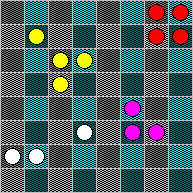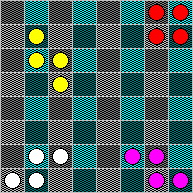
[Contents] [Chapter I] [Chapter II] [Chapter III] [Chapter IV]
In the beginning of a game, each player has four pieces with the choice of at most twelve possible moves per turn; each of the 64 squares of the Mentuldesk is accessible to him. If he loses one piece, matters do not differ much: he can still reach 48 squares and has up to six possible moves per turn (unless his pieces are too much scattered across the board). However, if he loses another piece, the situation changes radically. His remaining two pieces are bound to a 1-dimensional subspace of the 2-dimensional board, which makes him practically defenceless and unable to attack other players. With at most two possible moves per turn he cannot affect the further course of the game much, and usually loses his remaining pieces soon. A player with only one or no piece left is in statura.
For this reason, it is important to take care never to lose more than one piece in the course of a game.
With non-standard boards, the numbers may differ, but the general picture is the same; one must always check how many pieces one may lose without getting bound to a subspace of the board. I give these numbers when introducing the boards in Chapter III.
It is plain that more compact figures of a player's pieces are more preferable than scattered ones, for the scattered positions are less mobile (many couples of pieces aiming off the board) and even dangerous (at a loss of a piece, one might get quite paralyzed). Preferable shapes are those that can be domatized within two moves.
With those of non-standard boards that have no borders this advice does not apply; the more total the symmetry function, the less the importance of the rule. (See the Board Requirements and the Totalness Survey.)
Unlike chess, it is usually not very wise to capture an opponent's piece while any of your pieces remain attacked; a piece-against-a-piece exchange does not work in Mentula, for there are two players more who do not lose anything and so get one piece against you and your opponent. The exception is the final stage of the game when only two players remain on the board or a fight of firm coalitions when pieces on each side count more than an individual score; then the usual tactical rules known from chess would apply.
For the very same reason, you must not capture an opponent's piece that is under an attack of another player. With the classical Mentuldesk, no player can protect his own pieces by one another (because of the property of four-colorness, see the Rules; this is not necessarily true with other boards). An attacked piece, however, can be defended by an ally if he also attacks the same piece; the opponent cannot capture it and the piece is safe. This second attack of an ally's attacked piece is called sheltering the piece.
The following figure shows an example of sheltering. Suppose White and Magenta made a coalition against Yellow and Red. Yellow in his last move attacked White d3 which cannot be moved. Magenta (to play), however, can shelter it by g3-f3-e3. This way, White d3 will be saved.

Note that Magenta's counter-attack g3-f4-e5 would not save d3, since Red who moves before Magenta could shelter Yellow d6 by h7-g7-f7 or counter-attack Magenta by h8-g7-f6.
We could see that, paradoxically, a piece under a double attack is safe. However, it is not wise to move your piece onto a double-attacked square, unless one of the attacking players is your ally: for the first attacker to play can withdraw the attack, to allow the second attacker to capture your piece; and they can do so before you get any chance to move away. See the following figure:

If White plays 1. b1-c2-d3 supposing to be safe under the double attack of Yellow and Magenta, the game may proceed:
1. ... c5-c6-c7 g8-g7-g6 h1-f2xd3and White has lost the piece.
Sleiching (pronounced: shlaykhing) is a game strategy named after Petr Sleich, a Czech student of mathematics in the late 1980's. When the people who taught me Mentula played it for the first time in Warsaw (see the Origin of the Game), Petr Sleich reportedly used to move just to and fro in his corner of the board. After his opponents lost some pieces in a fracas he was not involved in, he became the strongest player on the board and won easily. He used this strategy steadily and won most of the games first, yet in long terms the strategy was not successful: when his opponents percieved it, all further games had the same scenario: three united armies marched forth at the very beginning of the game and with corporate effort devoured all Sleich's pieces, and only then started to fight each other.
Thus, the strategy of sleiching may be used but inconspicuously and not too often, lest your opponents should notice you are using it; their revenge in further games would be even more fierce than if you betray a coalition.
Of course, sleiching can hardly be done with those of non-standard boards that have no corners, e.g. the torus, where all parts of the board are the battlefield.
A single player can only hardly do any harm to another one; he can usually attack at most one opponent's piece which gives the opponent time enough to defend it (this is why 3:3 or 4:4 endings are usually drawn). The best chance to rob an opponent of his pieces is therefore cooperation. This cooperation may either be random (it is usually a good idea to attack another piece of an adversary if he has already got one attacked) or systematic. A coalition of two or more players has much greater chance to win than a single player. Since there are too many factors (some of them even external to the game itself) that affect forming coalitions, all I can say here is few brief remarks and observations that do not apply universally.
First it must be said that a casual cooperation in double attacks does not necessarily mean establishing a coalition. The word 'coalition' means an allegiance that lasts for some time at least and allows a player to trust the partner that he will not capture the player's pieces and will help to save them if needed.
Coalitions are either natural or negotiated. Natural coalitions are those necessitated by the game situation. For example, if the players' remaining pieces are 4:3:3:0 and nothing is previously negotiated, it is of vital importance for those with three pieces to join against the strongest one. Even if there are some previously negotiated coalition treaties, a change of the game situation can make a pressure towards a coalition change. One must always decide whether it is better for him to preserve the current coalition (and also whether he can still trust it) or rather to destroy or even betray it and make a new one (it must be, however, remembered that there are concerns regarding not only the current game).
When negotiating a coalition, it may be useful to make an agreement about what shall be done after the coalition conquers its adversaries: it makes the coalition partners more operational (if they can trust each other), since they do not have to take care about advantageousness of their position with respect to each other when the coalition is about to win. It also allows to capture the remaining pieces of the other party, thus eliminating the possibility that they get some points at the end. Although treachery to such a treaty will almost certainly lead to victory, its karmic consequences in the following games make it quite disadvantageous.
Common reasons for making a natural coalition are weakness and strength. Two weakened players should be natural allies against the stronger one(s); the stronger players, on the other hand, may make a coalition against the weaker one(s) so as to eliminate them from the board more easily and only then fight against each other or share the victory. It is more difficult to form an efficient coalition for players who start at opposite corners, since their pieces are separated by the battlefield and so they cannot shelter each other well. The slight advantage of the first move may perhaps be a minor reason for the natural coalition of the first 2-3 players to play at the very beginning of the game.
Coalition negotiations give an opportunity to exert eloquence, especially when you have to dissuade someone from a natural coalition which would be fatal for you. The situation is quite different if the 'silent' game is performed (see the Game Conduct). The fact that all coalitions must only stem from the game situation leads to a much greater weight of the natural reasons in the beginning of the game, a greater respect to coalitions already confirmed and much greater sensitiveness to a previous betrayal in the next games. The coalitions are therefore much more stable in a silent game.
The ways to offer and accept an allegiance in a silent game are various. One of them is to shelter a potential ally's piece, who can eventually show his acceptance by leaving the piece attacked by you for another move after the third party withdraws its attack (but he cannot be sure the sheltering was not random or a trap). Yet perhaps the most common way is to play each for his own account in the beginning of the game, taking all opportunities to deprive any adversary of his pieces (cooperation in double attacks does not necessarily mean establishing a coalition) and only when the natural reasons for making a coalition are strong enough (for example, pieces 3:3:4:4), one may suppose the coalition established without further assurance procedures.
The influence of coalitions (and of decisions on preserving or changing them) on the game is so big that it often cannot be decided at all whether a move is good or not; it can only be considered with respect to a particular interest. The further course of a particular game depends on much more matters than the player's skill, which can only roughly be measured by his long term results. These features, however, make the game more interesting, since it can simulate the real life situations much better than games for two players or sides (which simulate just plain and brute 'win or die' fight).
[Contents] [Chapter I] [Chapter II] [Chapter III] [Chapter IV]